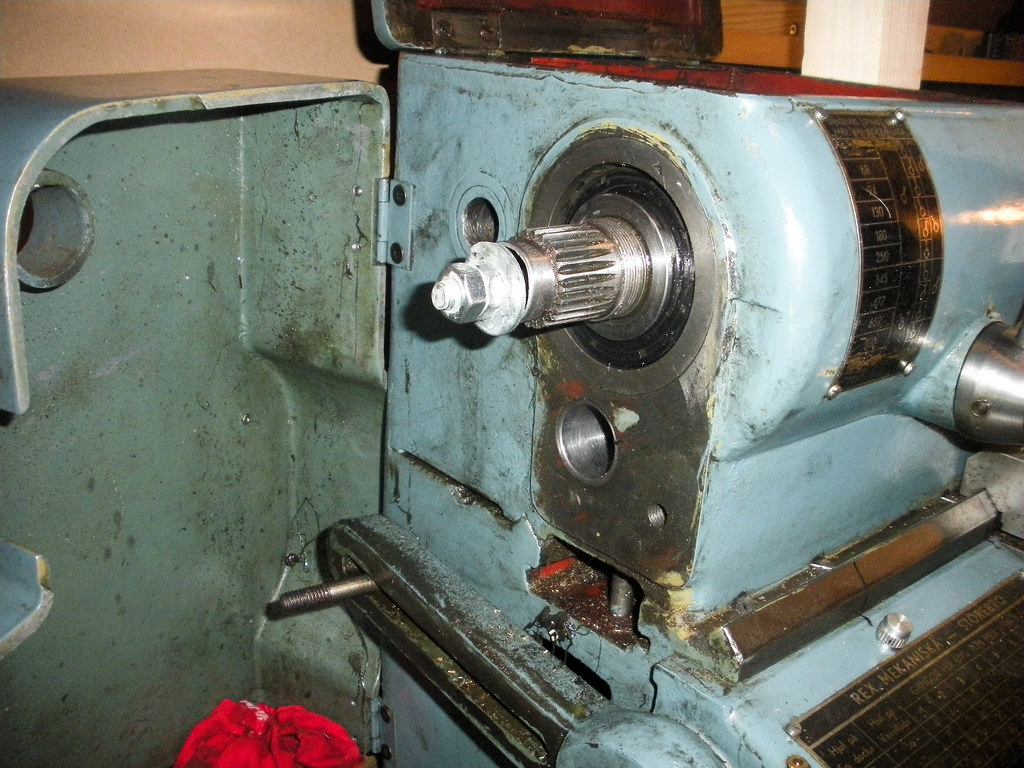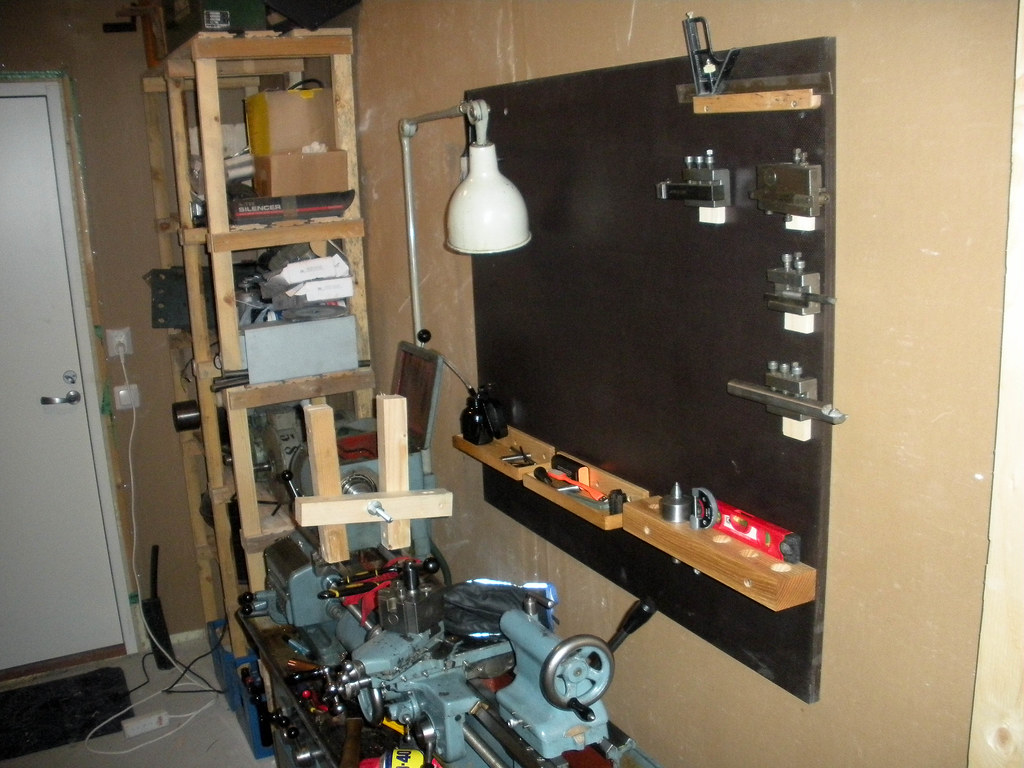- Forums
- Tools, Compressors and Metal Coatings
- Tools, Materials and Techniques
- Machining
- Lathes and other Machining Equipment
You are using an out of date browser. It may not display this or other websites correctly.
You should upgrade or use an alternative browser.
You should upgrade or use an alternative browser.
Rexvalter VF-118 lathe (was: old Myford Ml7)
- Thread starter DennisCA
- Start date
slim_boy_fat
Member
- Messages
- 29,363
- Location
- Scottish Highlands
I got it off, friction was the culprit as suspected earlier. Tightening my homemade puller and then tapping is what did it, refused to budge until I tightened it real hard, then tapped the rod with the hammer, then it moved a little bit. I repeated this for 5 minutes and it was off.


DennisCA
Member
- Messages
- 2,051
- Location
- Finland
If youve gone to that trouble fit new bearings
I thought I mentioned it earlier, those bearings are no longer made, at least not to high precision specs. And probably hundreds of euros a piece. It would be pointless to replace them with auto grade 30 euro bearings, might even be worse.
DennisCA
Member
- Messages
- 2,051
- Location
- Finland
This guy on practical machinist gives me some hope
http://www.practicalmachinist.com/vb/archive/index.php/t-217848.html
http://www.practicalmachinist.com/vb/archive/index.php/t-217848.html
Are you absolutely sure the problem is the spindle bearings? Many a home hachinist has encountered a machining problem their slightly more experienced buddies diagnose as "bearings" when the actual problem ("chatter" is a common one) is due to poor work or tool support, tool design, slow feed or a variety of other causes having simple remedies.
I've opened spindle cartridges and head stocks that have been in daily service in heavy industry for 50 years. The reason for entering the spindle was a broken shifter, fix a wobbly control, re-key a control lever etc. The opportunty for examining the spindle bearings and other internal parts is a rare one and they were inspected as a matter of course to the extent possible without actually disassembly. While the spindle preload may have relaxed a trifle and the visible part of the bearing races show indentations from particles in the lubricating oil the bearings still turned round and true and a listening ear on a stethoscope could detect no more than a whisper of a whir when the spindle ran at top speed.
Spindle bearings do fail in service and have to be replaced. My question is why are failed spindle bearings so frequent a diagnosis among home shop machinists compared to industry experience as a whole? Are spindle bearings getting a bum rap? Sometimes I wonder.
Machine tools spindles are traditionally so robust and over-designed they never fail from long service of heavy loads and frequent shock. If they do fail it's from rust, dirt, or a mechanical disaster sufficient to damage most components engaged in the driving train as well.
Finally there is failure mode. Rolling element bearings seldom fail in a way that causes radial or axial clearance except in extremis. The normal falure mode is race fatigue where repeated passing of loaded rolling elements cause fatigue which progress into micorcracks that merge to from spalls that leave behind pits. Spall succeeds spall propogating into a continuous track of spalling onm the races. It's at this point that bearing noise becomes audible over the normal idle machine sounds as a rumble or rattle. Preload may not be affected.
Loss of preload is not evidence of bearing falure. It's evidence of failure of the preload lock nut, axial shifting of bearings not tightly shouldered, incorrect ntal preload setting, deformation of mechanical parts. etc.
Well done, your persistence has paid off! I'd be like that when taking something apart, a combination of not letting it beat me & curiosity on how it all fits together.
You learned a lesson, using a puller to force something apart doesn't always work. Most of the time the best way is to put some tension on with the puller then apply a few well placed hammer taps or some heat or both!
Have you tried running the lathe without the back shaft fitted to see if the noise has gone?
You learned a lesson, using a puller to force something apart doesn't always work. Most of the time the best way is to put some tension on with the puller then apply a few well placed hammer taps or some heat or both!
Have you tried running the lathe without the back shaft fitted to see if the noise has gone?
DennisCA
Member
- Messages
- 2,051
- Location
- Finland
Thanks, I cleaned so much gunk out of the spindle head this weekend, the few hours I had in the shop.
I'm gonna try and chuck up the spindle in my wood lathe (has it's own 3-jaw chuck) between centers and polish the part where the bearing seats. I have some fine trizact belts (600-ish) I figure will be suitable. I figure it should be OK, just need it to spin around so I can polish it slightly.
I'm gonna try and chuck up the spindle in my wood lathe (has it's own 3-jaw chuck) between centers and polish the part where the bearing seats. I have some fine trizact belts (600-ish) I figure will be suitable. I figure it should be OK, just need it to spin around so I can polish it slightly.
DennisCA
Member
- Messages
- 2,051
- Location
- Finland
Phew busy night, got the lathe back together now, more or less the same noise but I am more certain than ever that it's not a bearing noise. I haven't yet fully tried adjusting the nut in a systematic fashion, just tightened it up and it seems the runout now is maybe 50-60% of what it was before. Not perfect but an improvement.
Sadly there was no time for pictures during, I'll have to take some pictures of it assembled afterwards.
Sadly there was no time for pictures during, I'll have to take some pictures of it assembled afterwards.
Pete.
Member
- Messages
- 14,947
- Location
- Kent, UK
You'll have to carefully monitor the headstock temperature when you first start running the machine. If it gets any hotter than you can comfortably keep your hand on when it's held at full speed for a while you'll have to let some pre-load off the bearings.The bearing arrangement is a bit old fashioned having one taper bearing each end of the spindle. Later developed lathes had opposed pairs of bearings at the front and a floating ballrace at the rear end. This was to combat problems with the clearances changing as the headstock and spindle warmed up.
DennisCA
Member
- Messages
- 2,051
- Location
- Finland
I tried running it for a minute or so at high speed but it didn't feel any warmer and bloody hell when I started it going the other way at high RPM the 3 jaw chuck unscrewed and fell out 
 Don't really know how one prevents this in the future, thought I had it tight.
Don't really know how one prevents this in the future, thought I had it tight.
I also checked runout on the three jaw chuck with a ground shaft and the needle went almost half the way around.

 Don't really know how one prevents this in the future, thought I had it tight.
Don't really know how one prevents this in the future, thought I had it tight.I also checked runout on the three jaw chuck with a ground shaft and the needle went almost half the way around.
Seadog
Save the planet. It's the only one with rum!
- Messages
- 12,952
- Location
- NE London - UK
I tried running it for a minute or so at high speed but it didn't feel any warmer
Boxford recommend 15 minutes, Dennis.
DennisCA
Member
- Messages
- 2,051
- Location
- Finland
I made a "burr file" after I read about it on Practical Machinist. Used an old piece of single cut file, ground the file teeth flat so the file doesn't cut anymore on a flat surface, only cuts raised portions, like burrs and such. Good for cleaning up way damage.
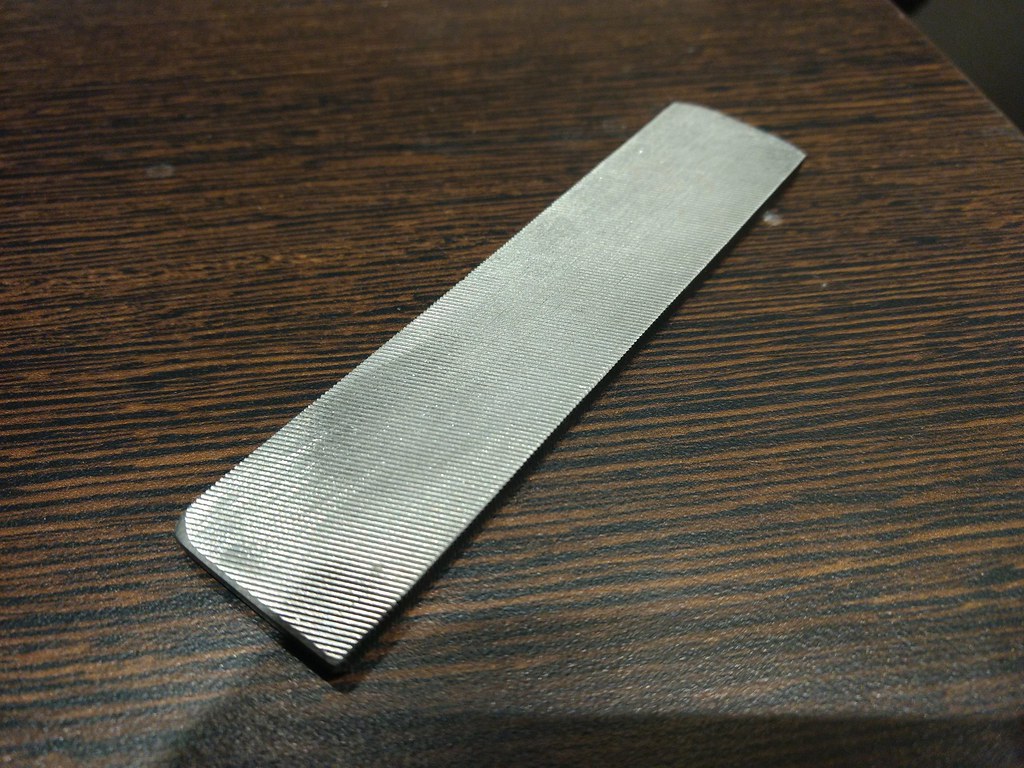
Not doing much practical stuff with the lathe yet, mostly just making shavings, grinding HSS and testing what does what. From what I've tested so far with several HSS tools, something like in the image below gets the best results at the 3rd highest speed (900 something rpms), based on the formulas I've read that's quite a bit higher than what I've heard is recommended for HSS. Does it say something about my HSS grinding skills, or something else? Some of the tools I did not grind but they came with, like the one below:
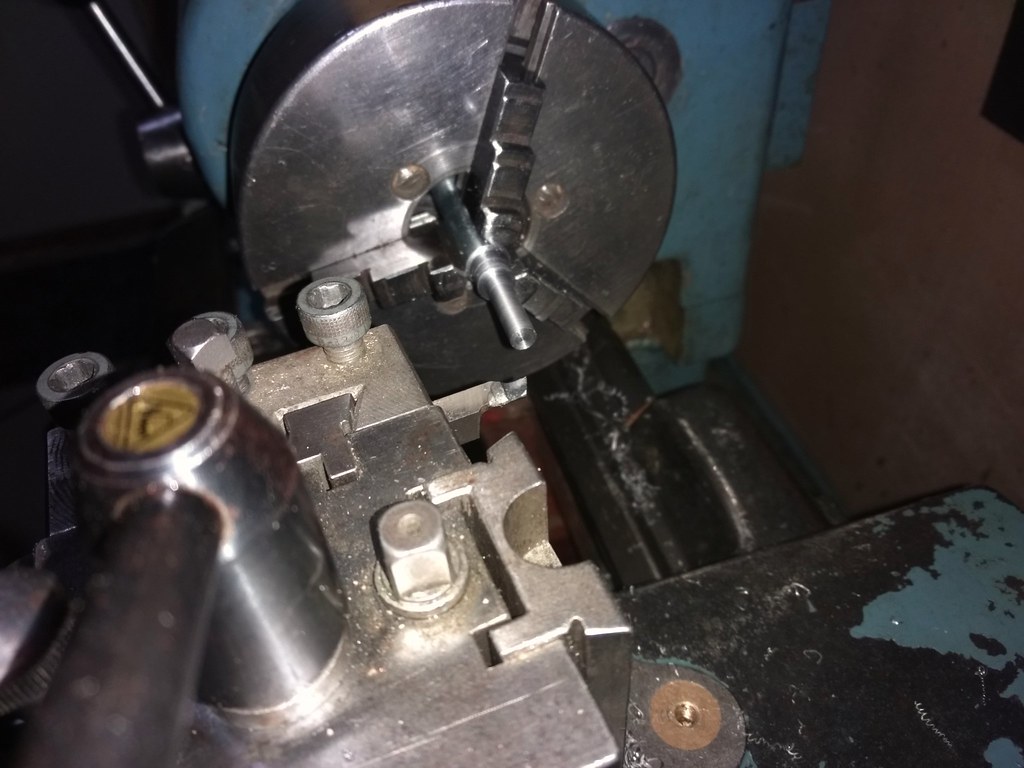
Another thing I've noticed is that the top slide moves easily, when doing a facing cut it will quite easily move sidewards unless I hold it steady. Do I need to tighten up the cross slide, I think it can be set behind the lathe to increase friction. I kinda figured there'd be a stop of some kind but there's no such thing.
Also would HSS holders like this be better than grinding thicker, solid bars of HSS steel? Seems this would use less steel and use it more effectively:
https://www.chronos.ltd.uk/acatalog/lax1nl.jpg

Not doing much practical stuff with the lathe yet, mostly just making shavings, grinding HSS and testing what does what. From what I've tested so far with several HSS tools, something like in the image below gets the best results at the 3rd highest speed (900 something rpms), based on the formulas I've read that's quite a bit higher than what I've heard is recommended for HSS. Does it say something about my HSS grinding skills, or something else? Some of the tools I did not grind but they came with, like the one below:

Another thing I've noticed is that the top slide moves easily, when doing a facing cut it will quite easily move sidewards unless I hold it steady. Do I need to tighten up the cross slide, I think it can be set behind the lathe to increase friction. I kinda figured there'd be a stop of some kind but there's no such thing.
Also would HSS holders like this be better than grinding thicker, solid bars of HSS steel? Seems this would use less steel and use it more effectively:
https://www.chronos.ltd.uk/acatalog/lax1nl.jpg
Also would HSS holders like this be better than grinding thicker, solid bars of HSS steel? Seems this would use less steel and use it more effectively:
https://www.chronos.ltd.uk/acatalog/lax1nl.jpg
I use J & S ones for 1/4"HSS,
https://www.chronos.ltd.uk/acatalog/lax1nl.jpg
I use J & S ones for 1/4"HSS,
DennisCA
Member
- Messages
- 2,051
- Location
- Finland
or you mean the saddle is moving away? Is there a clamp screw on it to lock it off, or do you lock it off with the gearbox?
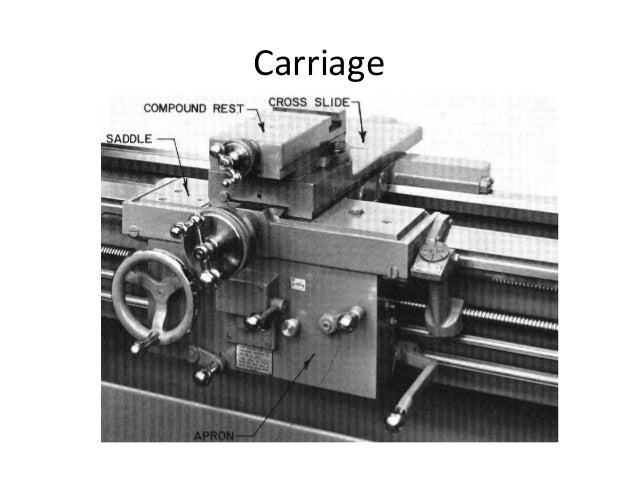
This is what I meant yeah, and I don't see a lock. I could use the half nuts as a stop if I disengage the feed to the gearbox. Seemed a bit kludge though.




